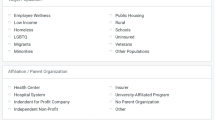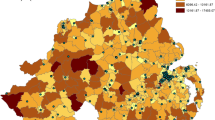Abstract
To develop a mobile clinic influence index, which could allow mobile clinic managers to prioritize geographic regions and allocate resources systematically. The mobile clinic primary care service index was constructed taking into account miles traveled by the mobile clinic, the speed of the mobile clinic, number of primary care providers available in a primary care service area (PCSA), the total population in a PCSA, and the number of primary care providers per mobile clinic program. To illustrate the application of the mobile clinic influence index, we use the case of selected primary care mobile clinic programs operating in North Carolina and Florida. A survey of selected mobile clinic programs from Texas, Georgia, Florida, and North Carolina, in rural and urban zip codes. PCSAs in various counties in North Carolina and Florida experienced varying degrees of additive effects of having mobile clinic providers service these areas. The mobile clinics in these counties were therefore influential in delivering critical primary healthcare services to at-risk populations. The index provides a valuable unit of measure to enable program managers of primary care mobile clinics to allocate resources as needed.
Similar content being viewed by others
References
Attipoe-Dorcoo S et al. (2018) An overview of costs, utilization, geographical distribution & influence of mobile clinics in rural healthcare delivery in the United States. (Doctoral dissertation, The University of Texas School of Public Health).
Bouchelle, Z., Rawlins, Y., Hill, C., Bennet, J., Perez, L. X., & Oriol, N. (2017). Preventative health, diversity, and inclusion: A qualitative study of client experience aboard a mobile health clinic in Boston, Massachusetts. International Journal for Equity in Health, 16(1), 191.
Cecil G. Sheps Center for Health Services. (2018) NC Rural health research program: 83 rural hospital closures: January 2010–present. http://www.shepscenter.unc.edu/programs-projects/rural%0Ahealth/rural-hospital-closures/%0A. Published 2018. Accessed January 18, 2018.
Fields, B. E., Bigbee, J. L., & Bell, J. F. (2016). Associations of provider-to-population ratios and population health by county-level rurality: Provider ratios and county-level health. The Journal of Rural Health, 32(3), 235–244. https://doi.org/10.1111/jrh.12143.
Foutz, J., Artiga, S., & Garfield, R. (2017). The role of Medicaid in rural America. Kaiser Family Foundation.
Goodman, D. C., Mick, S. S., Bott, D., Stukel, T., Chang, C. H., Marth, N., et al. (2003). Primary care service areas: a new tool for the evaluation of primary care services. Health Services Research, 38(1p1), 287–309.
Guagliardo, M. F. (2004). Spatial accessibility of primary care: concepts, methods and challenges. International Journal of Health Geographics, 3(1), 3.
McGuckin, N., & Fucci A. (2018) Summary of travel trends: 2017 National Household Travel Survey.
NBER. (2019) Dartmouth atlas data - primary care. https://www.nber.org/data/dartmouth-atlas-primary-care-service-area-pcsa.html. Published 2019. Accessed September 7, 2019.
Ojamaa LS et al. (2014) Achieving health equity through community-clinical linkages. In: January 2014 Summit, Massachusetts partnership for health promotion and chronic disease prevention, U.S. Department of Health and Human Services. http://www.mass.gov/eohhs/docs/dph/com-health/chronic-disease/140116-ojamaa-and-calista-presentation.pdf. Published 2014. Accessed March 26, 2017.
Probst, J. C., Moore, C. G., Glover, S. H., & Samuels, M. E. (2004). Person and place: The compounding effects of race/ethnicity and rurality on health. American Journal of Public Health, 94(10), 1695–1703.
Rural Policy R. (2019) Rural taxonomy of population and health-resource characteristics. https://rupri.public-health.uiowa.edu/Place/taxonomy.html. Published 2019. Accessed September 21, 2019.
Starfield, B., Shi, L., & Macinko, J. (2005). Contribution of primary care to health systems and health. The Milbank Quarterly, 83(3), 457–502. https://doi.org/10.1111/j.1468-0009.2005.00409.x.
U.S. Department of Agriculture. (2016) https://www.ers.usda.gov/topics/rural-economy-population/rural-classifications/what-is-rural/. Published 2016. Accessed April 24, 2016.
Yu, S. W., Hill, C., Ricks, M. L., Bennet, J., & Oriol, N. E. (2017). The Scope and Impact of Mobile Health Clinics in the United States: a Literature Review. International Journal for Equity in Health, 16(1), 178.
Zhu, X., Mueller, K. J., Vaughn, T., & Ullrich, F. (2015). A rural taxonomy of population and health-resource characteristics. Rural Policy Brief, 4, 1–6.
Acknowledgements
The authors will like to acknowledge the Mobile Health Clinic Association (MHCA) for their role in the data collection. Other organizations and individuals who helped make this work possible include the Harvard Mobile Van, St. David’s Foundation and Texas Children’s Hospital, who were instrumental in the survey development.
Funding
The authors will like to acknowledge the University of Texas School of Public Health in Houston for providing a doctoral dissertation award that supported this research.
Author information
Authors and Affiliations
Corresponding author
Ethics declarations
Conflict of Interest
The authors report no conflicts of interest.
Findings in the paper were presented as posters at both the 2019 AcademyHealth and American Evaluation Association conferences.
The authors declare that they have no competing interests. The authors will like to acknowledge the University of Texas School of Public Health in Houston for providing a doctoral dissertation award that supported this research. Each author made substantial contributions to the conception, design, analysis, and interpretation of data, as well as approve the submission.
Additional information
Publisher’s Note
Springer Nature remains neutral with regard to jurisdictional claims in published maps and institutional affiliations.
Rights and permissions
About this article
Cite this article
Attipoe-Dorcoo, S., Delgado, R., Lai, D. et al. Geographical Influence of Mobile Clinics in the Southern United States. Appl. Spatial Analysis 14, 81–87 (2021). https://doi.org/10.1007/s12061-020-09345-4
Received:
Accepted:
Published:
Issue Date:
DOI: https://doi.org/10.1007/s12061-020-09345-4




